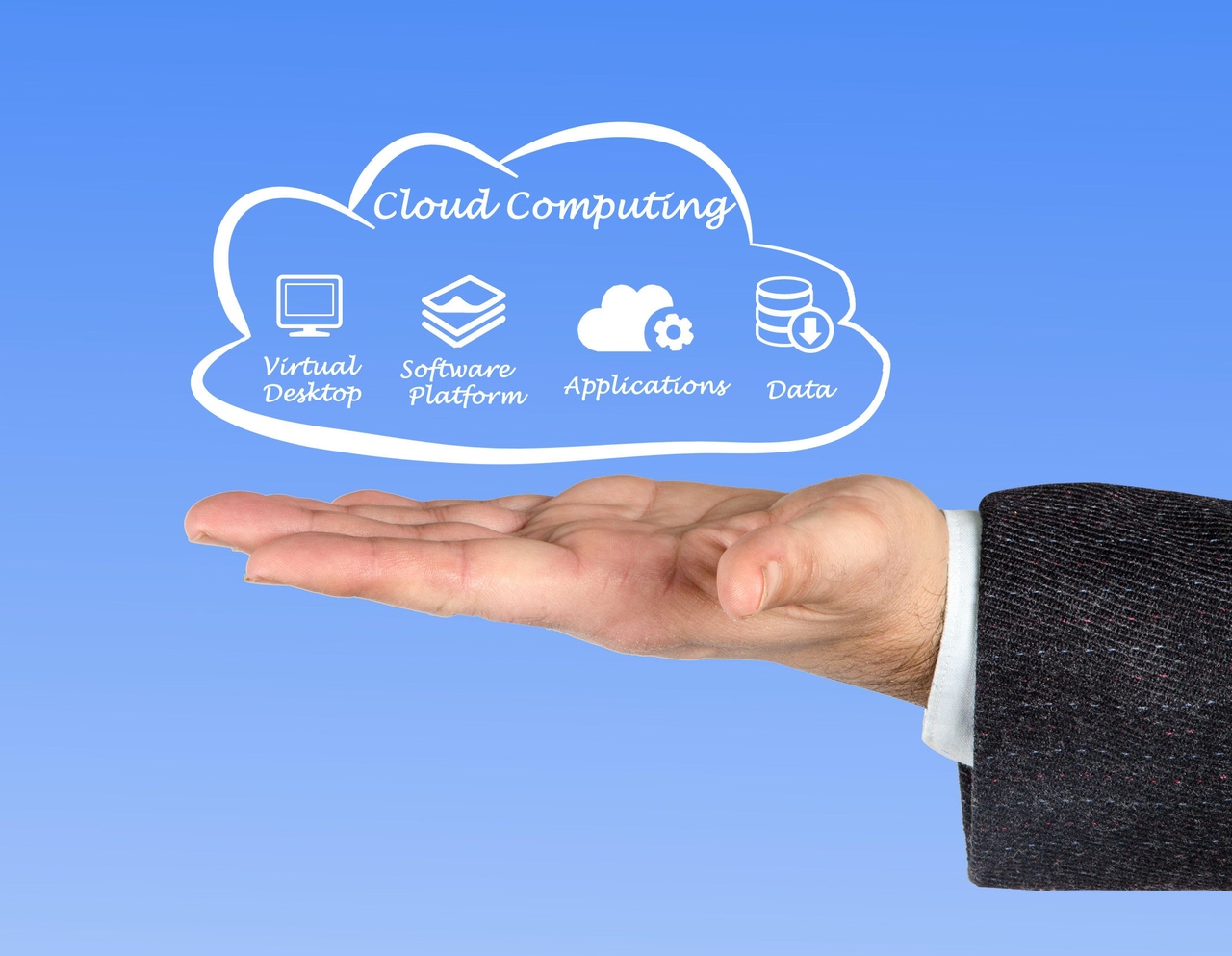What Is Cloud Virtual Desktop Infrastructure (VDI)?
Cloud VDI is gaining in popularity because companies see the potential for cost savings in hardware, networks, and software, as well as in the IT staff hours needed to support desktops. Additionally, a cloud-based VDI gives companies more flexibility in scaling resources upward or downward.
September 3, 2024

Cloud Virtual Desktop Infrastructure (VDI) is a cloud-based version of virtual desktop infrastructure in which virtual desktop computers are hosted in the cloud.
What is a virtual desktop? It is any type of device (e.g., desktop, laptop, smartphone, tablet) used by a user to access resources, such as operating systems, applications, processing, and storage on a VDI virtual desktop infrastructure network that the user never physically sees.
Both VDI and cloud VDI seek to do the same thing: enable users to access their normal office desktop IT environments “virtually”—from any device anywhere. The difference is that with cloud VDI, all of the hosting of this virtual desktop capability is in the cloud. With traditional VDI, the hosting remains in the company’s central data center.
Comparing Cloud VDI to Traditional VDI and DaaS
In a VDI deployment, corporate IT maintains the VDI computing infrastructure for virtual desktops. Other offers, such as Desktop-as-a-Service and on-premises VDI, have comparable benefits. But there are many differences that set cloud VDI apart.
Distinctions Between Cloud VDI and On-Premises Solutions
On-premises desktop computing and support can take two forms:
It can be through the distribution of physical machines and devices to users that users use in-house and that IT supports the central data center with networks, storage, and other hardware and software.
It can take the shape of in-house VDI, where users can use any device anywhere to obtain the same access and computing capabilities from the corporate data center that they would if they were sitting at an office desk using a dedicated physical machine.
In both cases, IT is responsible for budgeting, installing, and maintaining the data center desktop network, storage, and other resources. This includes installing and maintaining the necessary security and any data center hardware and software upgrades for these resources. IT also has the flexibility to modify its desktop architecture and deployments.
On the other hand, with cloud VDI, corporate IT cedes control of desktop operations to a third-party cloud provider. Companies that use cloud VDI no longer have to plan and budget for their own desktop, network, storage, etc. They also have the flexibility to scale up or down their cloud virtual desktop use on demand.
The cloud provider sets up and maintains the supporting network, storage, and other resources in the cloud and is responsible for any upgrades needed. Company users obtain the same virtual desktop computing capabilities that they would with on-prem, internal VDI, but since it is the cloud provider that defines and sets up infrastructure, IT loses the ability to modify or customize this architecture. Security is set up and maintained by the cloud provider.
The Intersection of Cloud VDI and DaaS
DaaS (Desktop-as-a-Service) and cloud VDI are both forms of cloud VDI, but they vary in approach.
With cloud VDI, the customer gets a fixed VDI infrastructure in the cloud that looks much like the VDI infrastructure that IT would have in its own on-premises data center. In this environment, it is possible for a company to operate VDI on the cloud as a single tenant (i.e., the cloud VDI infrastructure is dedicated to one company alone).
With DaaS, virtual desktop resources (e.g., operating systems, applications, storage, network support, etc.) are streamed to users as they need and consume them. When the users cease work, the resources are deallocated—and may be allocated to someone else in another company. DaaS is a shared, multi-tenant service that many client companies use.

(Credit: Illia Uriadnikov / Alamy Stock Photo)
How Cloud VDI Enables Desktop Delivery Transformation
The delivery of IT resources and support to desktops began with “fat” servers and desktops that were loaded with operating systems, applications, security, hard drive storage, etc.—all on a single user’s desktop computer. While many users liked this all-in-one physical desktop approach that enabled them to store work on hard drives, it complicated IT’s job when it necessitated visits to the field to repair or fine-tune workstations. It was also more difficult for IT to ensure that the latest versions of operating systems, applications, and security were on all desktops.
VDI transforms desktop service delivery and maintenance because, with VDI, all operating systems, applications, security protocols, storage, and network support are virtualized. The actual physical resources are located in the corporate data center and are loaded onto users' desktops and devices as they need them. Since VDI is virtual, it also allows users to tap into IT resources from any device, whether the user is in the office using his desktop, at home using a tablet, or in the field using a smartphone. Since operating systems, applications, security, storage, and network support are provisioned directly from the data center, IT has a centralized way of maintaining these resources, and personal visits to user areas are reduced.
Cloud VDI is further transforming traditional VDI into a cloud-based service where IT relieves most of its desktop workload in the data center. With cloud VDI, a third-party vendor maintains and supports the virtual desktop infrastructure.
Easy Desktop Setup
From the users' perspective, a virtual desktop is what they use on their smartphone, tablet, or thin client desktop device to access the company IT resources that they need to do their jobs. Users sign onto the virtual network that has either been set up for them by corporate IT or by a virtual desktop infrastructure cloud provider. Once users sign in, the screens on their devices are populated with icons that provide access to the applications and other IT resources for which they are authorized.
On the IT side, desktop setup must be done. Whether it is internal IT with its own VDI network or an outside cloud VDI provider, security, application permissions, and access to other IT resources must be defined for each desktop user on the VDI network. VDI cloud providers get their authorization specifications from corporate IT. Once individual user authorizations are defined, they can be implemented by pressing buttons on a virtual network display to create a virtual desktop for each user. After this, each user's virtual desktop is populated with the IT resources for which the user is authorized. These resource authorizations apply to a user regardless of which device a user uses—desktop, tablet, or smartphone.
Improved Data Security
When desktop networks are virtualized, security is improved because IT can reduce the risk of users adding unknown (and potentially dangerous) resources to their desktop machines. Virtual desktop infrastructure also enables centralized monitoring of user activities.
The same is true for cloud VDI. The cloud vendor can enable and monitor security in the same way that IT does. The cloud vendor might even improve security over what corporate IT could do because the vendor might get quicker notice of the latest security fixes for operating systems and applications.
On the flip side, IT might see more security risks with VDI on the cloud because IT no longer has a direct window into what the cloud VDI provider is doing with security, especially in a multi-tenant cloud VDI model like DaaS, where many different companies are sharing the same IT resources.
Simpler and Assured Data Backup
Large enterprises have highly developed data backup procedures that are performed consistently and regularly. However, at SMBs (small and mid-sized businesses), data backups don't always occur on the same regularity.
The advantage of a cloud VDI or a DaaS provider is that they have numerous company clients. Consequently, they have highly professional data backup operations that their clients can depend upon. This greatly reduces IT worries.
Reduced IT Management and Administration Costs and Time
Cloud VDI and DaaS vendors fully manage the VDI desktop network. Because they serve many client companies, costs can be spread across these large client bases. This results in more economical desktop services for companies than if they were to use their own internal IT departments to manage VDI.
There is also a time savings for IT when it chooses to outsource VDI deployment and management to outside vendors. With outsourcing, IT no longer has to directly manage the day-to-day virtual desktop infrastructure because the cloud VDI or DaaS vendor is doing it. IT still has oversight and coordination responsibilities, but it doesn’t have to do the daily work.

(Credit: Michael Borgers / Alamy Stock Photo)
Security and Compliance Aspects of Using Cloud VDI Solutions
Cloud VDI vendors provide security tools and methodologies that corporate IT can use to define its security and governance standards on the cloud. IT must define and adjust these as security conditions change.
In many cases, there are learning curves because IT must master different sets of tools that each vendor provides. In other cases, IT can engage the cloud vendor to deploy and maintain security and governance. This can be a viable option for smaller companies, provided that the cloud VDI vendor can furnish them with a recent security audit, along with security and governance standards that meet or exceed their own.
Ability to Maintain Stringent Data Protection Standards
Whether VDI is done from the corporate data center or the cloud, data protection is improved with VDI because IT no longer has to worry about users storing data on their own device hard drives, which could be lost or compromised.
Large cloud VDI providers also provide regular data backups, and most will provide the tools or services to assure subscribers that they have the levels of data protection that their respective corporate security and governance standards require.
Ability to Ensure Regulatory Adherence with Cloud VDI
Cloud VDI and DaaS providers serve companies in a broad cross-section of industries, so they must be compliant with industry-specific regulations such as HIPAA (healthcare), PCI DSS (finance), NIST 800 171 (security), and CMMC L2 (encryption). Nevertheless, it’s important for corporate IT to ask for and review the latest security audits of the cloud/DaaS vendors they select to affirm that the vendors are in good standing.
Contracts with DaaS and cloud VDI vendors should contain provisions that enable IT to review the vendors’ audits annually. IT should also stay in touch with both vendors and its own auditors and regulators to ensure that new changes to security and compliance are promptly planned for and implemented.
Points to Consider with Using Cloud VDI
Cost is the major factor that most companies consider when they compare in-house VDI to VDI in the cloud. Almost always, cost reductions in cloud VDI will outperform those of in-house VDI because the cost of cloud VDI infrastructure deployments and services is spread over multiple corporate clients. IT also saves person-hours when it jobs out VDI to the cloud, as well as the need to fund new hardware, software, networks, and data lines.
A second point of consideration is security. The frequency of cloud security breaches is well known, and some companies with highly sensitive intellectual property are uncomfortable with outsourcing their security to the cloud. Instead, they prefer to retain and manage their own desktop infrastructures.
Finally, companies must consider the learning curves for multiple sets of cloud tools since each cloud vendor has its own tools for security, resource provisioning, fine-tuning, etc. The need for IT to master these multiple toolsets can be daunting.
How Do Users “Consume” Cloud VDI?
Users can consume VDI resources from any device that they use, whether desktop, smartphone, tablet, or other. In the case of "persistent" VDI, the user's virtual desktop is always loaded in the cloud and is ready to be downloaded to a user device upon request. These virtual desktop resources are assigned to the user and continue to exist, with the user being free to access them as needed.
In the case of DaaS, user resources are also defined and allocated virtually from the cloud, only they do not persist. In other words, the resources are allocated to the user when the user requests them, but once the user signs off, the resources are deallocated, and they return to a general resource pool that others can draw from.
How Network Performance Issues Impact Cloud VDI
When users work from home or in the field, both cloud and in-house VDI networks can be disrupted where there is reliance on wireless technologies like Wi-Fi or 5G that don't give the same level of data and service quality as hard-wired ethernet lines. If network interference occurs, screens can lock up, and data can be dropped. The amount of bandwidth that IT contracts with cloud vendors also has an impact. It is important to ensure that the bandwidth needed to support all users in a VDI deployment from the cloud is adequate.
Finally, security can become an issue if there are extensive security checks and data encryption when users sign on or access applications. Both have a tendency to bog down network performance.
The Need for Reliable User Connectivity
The need for reliable user connectivity anytime, anywhere, is paramount for companies today. This makes it important for IT to thoroughly vet any prospective cloud VDI or DaaS vendor for its reliability track record, in addition to visiting current vendor customers to see what their reliability experiences have been.
A second step is to include performance and reliability metrics in an addendum to any contract with a VDI or DaaS vendor. These metrics should be a central part of any RFP issued to a cloud VDI or DaaS vendor.
IT should also know in advance the current and projected bandwidth, security, and resource needs of its VDI users so it can have discussions with vendors on these elements and the levels of reliability its users expect before any contracts are signed.

(Credit: wsf AL / Alamy Stock Photo)
Getting Started With Cloud VDI
Cloud VDI is a great way to outsource support for desktop services. It can save IT many hours and also reduce costs. With cloud VDI, companies can also scale up or down resource usage, paying only for what they consume. Nevertheless, there are several caveats that should be considered before companies move to cloud VDI.
First, companies should thoroughly understand the resources, security, and governance needs of their own desktop infrastructure environments. What applications, storage, security, etc., must be supported? Do users need to work remotely as well as in-house? Must desktop support be available around the clock? What levels of bandwidth and reliability are needed?
Finally, there is the user side of VDI. Some users, especially those in finance, engineering, or senior management, prefer having fat client workstations so they can keep some of their work confidential and off the network. VDI uses thin clients, but there may be special cases where you have to maintain fat client machines.
Implementing a Cloud VDI Strategy
Companies entering into a cloud VDI deployment typically come from either an internal desktop or an internal VDI environment. They're moving to cloud VDI for what they believe will be efficiency gains and cost savings. In making this transformation, there are several important steps that companies should take:
Identify the business need: Why do you want to move to cloud VDI? Is it because more of your workforce is working remotely? Or to save investments in networks, hardware, and software? Do your users and executive management support the move, or it is just an IT idea?
A move to cloud VDI should only be taken if the company is behind it and understands the business reasons for making the move.
Size the cloud VDI: Working with users, determine who will be using the cloud VDI. Will it be everyone in the company or a subset of users? What storage, processing, thin clients, applications, etc., will be needed today and five years from now? Will your solution be scalable?
Identify the vendor: An RFP for a cloud VDI solution should include all of your cloud VDI requirements. The vendor should be able to assist you in right-sizing the cloud VDI solution that you need and should also have tools for developing, monitoring, and maintaining the VDI.
Ensure security and compliance: Request the latest security audit from the vendor for review. If the vendor doesn’t have a recent security audit, find another vendor. Compare vendor security and governance standards with your own. The vendor standards should meet or exceed your own standards before you sign an agreement.
Train IT: Once you find a cloud VDI vendor, train IT staff in cloud VDI management tools that are available from the vendor. Even if you plan to outsource most management to the vendor, IT should have technical training on the vendor’s tools in the event it wants to assume a larger management role.
Start small and run in parallel: The best way to move to cloud VDI is to start with a small group of users and then extend the network group by group. By initiating a pilot of the new cloud VDI with a small group of users, you have the opportunity to test all systems and resources and resolve any problems. Once the new cloud VDI infrastructure is running smoothly, you can expand it.
During the initial pilot trial period, the cloud VDI and your in-house VDI or physical desktop network should run in parallel so you can benchmark and compare performance between the two.
Selecting the Right Cloud VDI Provider
There are two fundamental flavors of cloud VDI: a "fixed" cloud infrastructure for your desktops that resides within the cloud instead of within your own data center and a desktop as a service (DaaS) cloud solution that allocates resources to your users' desktops as they need them, and that deallocates these resources when work is done. In the case of DaaS, the resources that your users receive from the cloud can be reallocated to users in other companies once those resources are free. Because resources are shared, costs for each company may be lower.
Most companies choose to go with a cloud VDI service from a large, established vendor such as Microsoft (Azure), IBM, Oracle, Amazon, etc. The reason is simple: these are "proven" cloud VDI providers that already are subscribed to by many companies. Most offer VDI in the cloud or alternately on-premises if you want.
Regardless of the cloud VDI provider you select, the provider should meet your business and technical requirements, be able to train your IT staff on cloud-based VDI management tools, and provide security and governance for your desktop infrastructure that meets or exceeds your own.
Summary
Cloud VDI is gaining in popularity because companies see the potential for cost savings in hardware, networks, and software, as well as in the IT staff hours needed to support desktops. A cloud-based VDI additionally gives companies more flexibility in scaling resources upward or downward.
As IT gains experience in cloud VDI, it will want to take advantage of cloud VDI tools and training that can give it more visibility into the cloud VDI, along with the ability to customize. At the other end of the spectrum are smaller companies that might prefer to just outsource their entire VDI to the cloud, provided that the cloud VDI provider can meet their security and compliance requirements.
In either case, the advantage of cloud VDI is that you gain flexibility in costing and deployment without feeling that you are locked into asset depreciation cycles and deployments that no longer fit your business.
About the Author
You May Also Like




